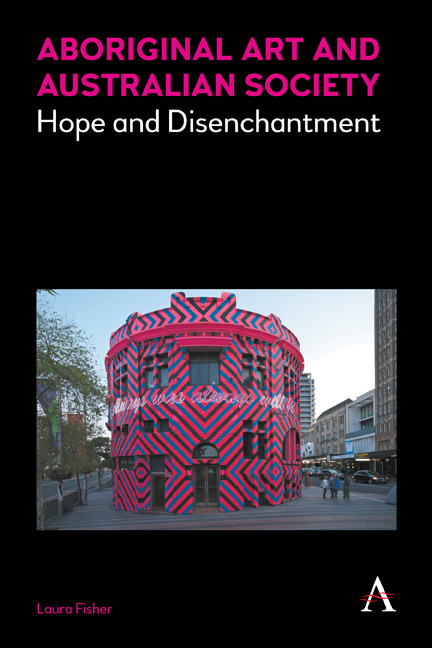Book contents
- Frontmatter
- Dedication
- Contents
- Preface and Acknowledgements
- Introduction
- Part I Governance, Nationhood and Civil Society
- Part II Contemporary Aboriginal Art in the 1980s
- Part III Negotiating Difference
- Part IV Aboriginal Art, Money and the Market
- Chapter 9 Ethics and Exploitation in the Aboriginal Art Market
- Chapter 10 ‘Aboriginal Mass Culture’ and the Cultural Industries
- Conclusion
- Notes
- References
- Index
Chapter 10 - ‘Aboriginal Mass Culture’ and the Cultural Industries
from Part IV - Aboriginal Art, Money and the Market
Published online by Cambridge University Press: 22 July 2017
- Frontmatter
- Dedication
- Contents
- Preface and Acknowledgements
- Introduction
- Part I Governance, Nationhood and Civil Society
- Part II Contemporary Aboriginal Art in the 1980s
- Part III Negotiating Difference
- Part IV Aboriginal Art, Money and the Market
- Chapter 9 Ethics and Exploitation in the Aboriginal Art Market
- Chapter 10 ‘Aboriginal Mass Culture’ and the Cultural Industries
- Conclusion
- Notes
- References
- Index
Summary
I have thus far sought to show that while claims about unethical conduct have been responsive to concerns about Aboriginal artists’ well-being, they have also arisen due to the interpenetration of very different models of commerce and manifest the problem of Aboriginal art's close relationship with money. In other words, the discourses around ethics have at least in part been symptomatic of the failure of the Aboriginal art movement to have been ‘regularised’ by the codes of the fine arts market (Shiner 2001). I wish here to widen the scope of this discussion and explore other economic factors that have destabilised the edifice of Aboriginal fine art. To this end I examine Australian cultural policy and visual culture, and some of the particularities of Aboriginal artistic work and the social worlds in which it takes place. My hope is that it will become clear that Aboriginal art is ensconced within commercial spheres and economic relationships (in addition to those already discussed) in opposition to which fine arts is typically defined.
A Critical History of ‘Aboriginal Mass Culture’ and Visual Culture
My efforts to develop a critical understanding of the tensions underlying the Aboriginal art market, and to better comprehend the status of those Aboriginal cultural forms that are embedded in the popular realm as opposed to, or in addition to, the fine arts realm, led me to formulate the concept ‘Aboriginal mass culture’ (Fisher 2014). Aboriginal mass culture can be summarised as an arena of cultural production that runs counter to, and poses ongoing problems for, the project of consecrating Aboriginal fine art. I see it as including those cultural forms that reproduce generic and stereotypical representations of Aboriginality and contain reductive and derivative variations of widely recognised Aboriginal art styles. These forms are immediately identifiable in the tourism souvenir market, but, as I will argue later, they have proliferated in a range of other contexts.
The concept of Aboriginal mass culture deliberately, and no doubt provocatively in the eyes of some readers, invokes the high/low culture dichotomy with its derogatory implications for the latter. I do not invoke this dichotomy uncritically: I am very mindful of the critiques of the hierarchical and ahistorical notions of high culture that have sustained the dichotomy (see, e.g., Clifford 1988; Shiner 2001…
- Type
- Chapter
- Information
- Aboriginal Art and Australian SocietyHope and Disenchantment, pp. 155 - 172Publisher: Anthem PressPrint publication year: 2016



